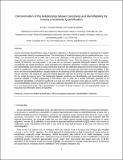Demonstration of the relationship between sensitivity and identifiability for inverse uncertainty quantification
Author(s)
Wu, Xu; Shirvan, Koroush; Kozlowski, Tomasz
DownloadSubmitted version (912.8Kb)
Publisher with Creative Commons License
Publisher with Creative Commons License
Creative Commons Attribution
Terms of use
Metadata
Show full item recordAbstract
Inverse Uncertainty Quantification (UQ), or Bayesian calibration, is the process to quantify the uncertainties of random input parameters based on experimental data. The introduction of model discrepancy term is significant because “over-fitting” can theoretically be avoided. But it also poses challenges in the practical applications. One of the mostly concerned and unresolved problem is the “lack of identifiability” issue. With the presence of model discrepancy, inverse UQ becomes “non-identifiable” in the sense that it is difficult to precisely distinguish between the parameter uncertainties and model discrepancy when estimating the calibration parameters. Previous research to alleviate the non-identifiability issue focused on using informative priors for the calibration parameters and the model discrepancy, which is usually not a viable solution because one rarely has such accurate and informative prior knowledge. In this work, we show that identifiability is largely related to the sensitivity of the calibration parameters with regards to the chosen responses. We adopted an improved modular Bayesian approach for inverse UQ that does not require priors for the model discrepancy term. The relationship between sensitivity and identifiability was demonstrated with a practical example in nuclear engineering. It was shown that, in order for a certain calibration parameter to be statistically identifiable, it should be significant to at least one of the responses whose data are used for inverse UQ. Good identifiability cannot be achieved for a certain calibration parameter if it is not significant to any of the responses. It is also demonstrated that “fake identifiability” is possible if model responses are not appropriately chosen, or if inaccurate but informative prior distributions are specified. ©2019
Date issued
2019-11Department
Massachusetts Institute of Technology. Department of Nuclear Science and EngineeringJournal
Journal of computational physics
Publisher
Elsevier BV
Citation
Wu, Xu, Koroush Shirvan, and Tomasz Kozlowski, "Demonstration of the relationship between sensitivity and identifiability for inverse uncertainty quantification." Journal of computational physics 396, 1 (November 2019): p. 12-30 doi 10.1016/j.jcp.2019.06.032 ©2019 Author(s) Keywords: inverse uncertainty quantification; modular Bayesian approach; identifiability; sensitivity
Version: Original manuscript
ISSN
1090-2716
0021-9991